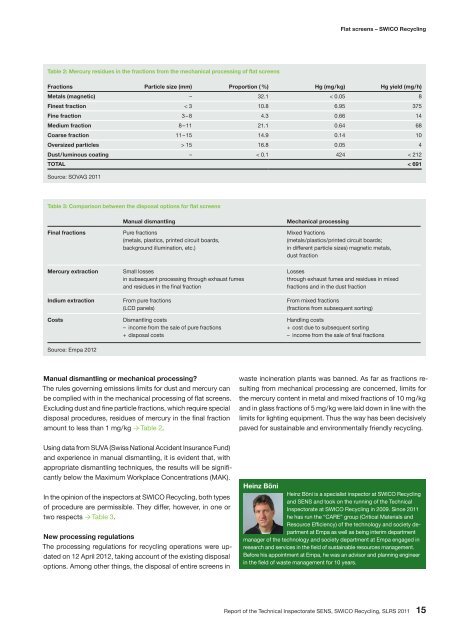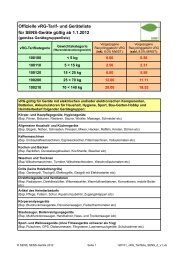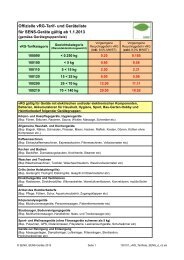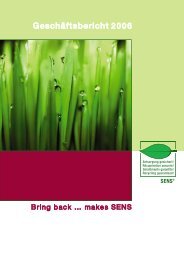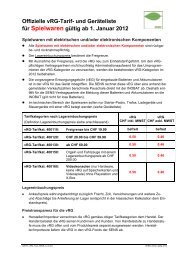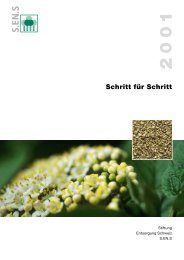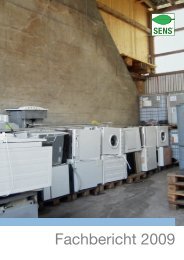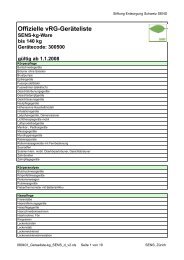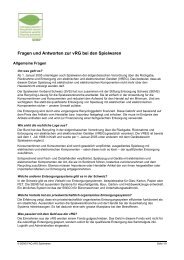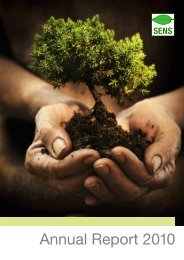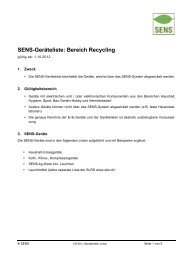Report of the Technical Inspectorate SENS, SWICO Recycling, SLRS
Report of the Technical Inspectorate SENS, SWICO Recycling, SLRS
Report of the Technical Inspectorate SENS, SWICO Recycling, SLRS
Create successful ePaper yourself
Turn your PDF publications into a flip-book with our unique Google optimized e-Paper software.
Table 2: Mercury residues in <strong>the</strong> fractions from <strong>the</strong> mechanical processing <strong>of</strong> flat screens<br />
Manual dismantling or mechanical processing?<br />
The rules governing emissions limits for dust and mercury can<br />
be complied with in <strong>the</strong> mechanical processing <strong>of</strong> flat screens.<br />
Excluding dust and fine particle fractions, which require special<br />
disposal procedures, residues <strong>of</strong> mercury in <strong>the</strong> final fraction<br />
amount to less than 1 mg / kg � Table 2.<br />
Using data from SUVA (Swiss National Accident Insurance Fund)<br />
and experience in manual dismantling, it is evident that, with<br />
appropriate dismantling techniques, <strong>the</strong> results will be significantly<br />
below <strong>the</strong> Maximum Workplace Concentrations (MAK).<br />
In <strong>the</strong> opinion <strong>of</strong> <strong>the</strong> inspectors at <strong>SWICO</strong> <strong>Recycling</strong>, both types<br />
<strong>of</strong> procedure are permissible. They differ, however, in one or<br />
two respects � Table 3.<br />
New processing regulations<br />
The processing regulations for recycling operations were updated<br />
on 12 April 2012, taking account <strong>of</strong> <strong>the</strong> existing disposal<br />
options. Among o<strong>the</strong>r things, <strong>the</strong> disposal <strong>of</strong> entire screens in<br />
Flat screens – <strong>SWICO</strong> <strong>Recycling</strong><br />
Fractions Particle size (mm) Proportion ( %) Hg (mg / kg) Hg yield (mg / h)<br />
Metals (magnetic) – 32.1 < 0.05 8<br />
Finest fraction < 3 10.8 6.95 375<br />
Fine fraction 3 – 8 4.3 0.66 14<br />
Medium fraction 8 – 11 21.1 0.64 68<br />
Coarse fraction 11 – 15 14.9 0.14 10<br />
Oversized particles > 15 16.8 0.05 4<br />
Dust / luminous coating – < 0.1 424 < 212<br />
TOTAL < 691<br />
Source: SOVAG 2011<br />
Table 3: Comparison between <strong>the</strong> disposal options for flat screens<br />
Manual dismantling Mechanical processing<br />
Final fractions Pure fractions<br />
(metals, plastics, printed circuit boards,<br />
background illumination, etc.)<br />
Mercury extraction Small losses<br />
in subsequent processing through exhaust fumes<br />
and residues in <strong>the</strong> final fraction<br />
Indium extraction From pure fractions<br />
(LCD panels)<br />
Costs Dismantling costs<br />
– income from <strong>the</strong> sale <strong>of</strong> pure fractions<br />
+ disposal costs<br />
Source: Empa 2012<br />
Mixed fractions<br />
(metals / plastics / printed circuit boards;<br />
in different particle sizes) magnetic metals,<br />
dust fraction<br />
Losses<br />
through exhaust fumes and residues in mixed<br />
fractions and in <strong>the</strong> dust fraction<br />
From mixed fractions<br />
(fractions from subsequent sorting)<br />
Handling costs<br />
+ cost due to subsequent sorting<br />
– income from <strong>the</strong> sale <strong>of</strong> final fractions<br />
waste incineration plants was banned. As far as fractions resulting<br />
from mechanical processing are concerned, limits for<br />
<strong>the</strong> mercury content in metal and mixed fractions <strong>of</strong> 10 mg / kg<br />
and in glass fractions <strong>of</strong> 5 mg / kg were laid down in line with <strong>the</strong><br />
limits for lighting equipment. Thus <strong>the</strong> way has been decisively<br />
paved for sustainable and environmentally friendly recycling.<br />
Heinz Böni<br />
Heinz Böni is a specialist inspector at <strong>SWICO</strong> <strong>Recycling</strong><br />
and <strong>SENS</strong> and took on <strong>the</strong> running <strong>of</strong> <strong>the</strong> <strong>Technical</strong><br />
<strong>Inspectorate</strong> at <strong>SWICO</strong> <strong>Recycling</strong> in 2009. Since 2011<br />
he has run <strong>the</strong> “CARE” group (Critical Materials and<br />
Resource Efficiency) <strong>of</strong> <strong>the</strong> technology and society department<br />
at Empa as well as being interim department<br />
manager <strong>of</strong> <strong>the</strong> technology and society department at Empa engaged in<br />
research and services in <strong>the</strong> field <strong>of</strong> sustainable resources management.<br />
Before his appointment at Empa, he was an advisor and planning engineer<br />
in <strong>the</strong> field <strong>of</strong> waste management for 10 years.<br />
<strong>Report</strong> <strong>of</strong> <strong>the</strong> <strong>Technical</strong> <strong>Inspectorate</strong> <strong>SENS</strong>, <strong>SWICO</strong> <strong>Recycling</strong>, <strong>SLRS</strong> 2011 15


